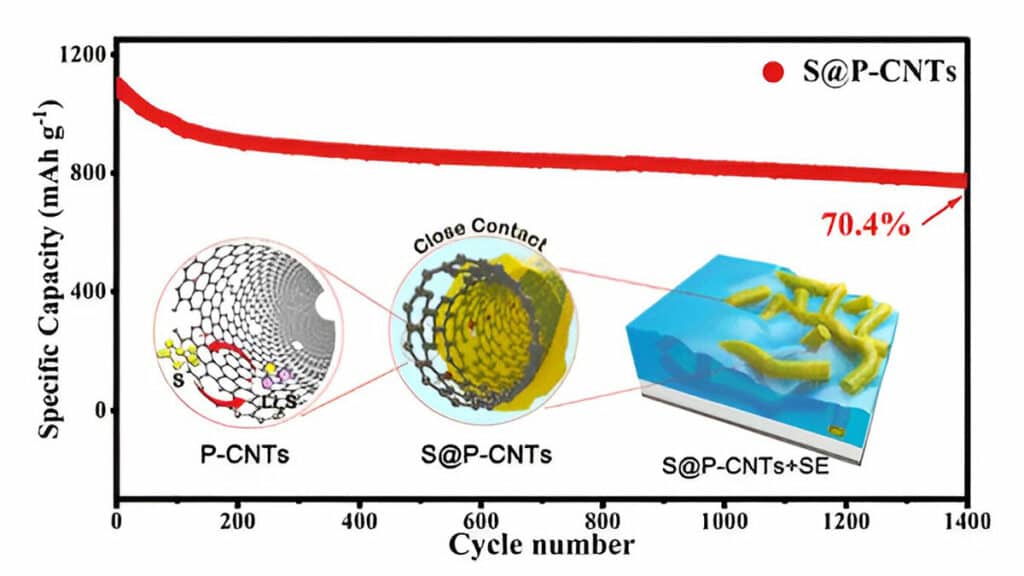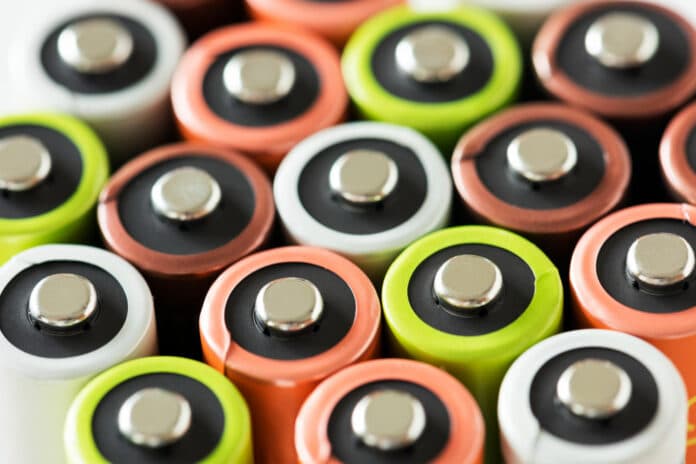To satisfy the emerging market demand, all-solid-state lithium-sulfur batteries are considered one of the most promising next-generation energy storage devices due to the high energy density, high safety, and low cost of sulfur.
However, it’s important to address the issue of insufficient interfacial contact between solid electrolytes and the active material of sulfur in order to optimize electronic and ionic conduction and reduce interfacial resistance and capacity decay.
Now, researchers from the Qingdao Institute of Bioenergy and Bioprocess Technology (QIBEBT) of the Chinese Academy of Sciences have made a breakthrough in defect engineering and performance improvement of all-solid-state lithium-sulfur batteries (ASSLSBs).
For their research, the researchers activated commercial carbon nanotubes (CNTs) to form porous-CNTs (P-CNTs), which are used as sulfur-bearing matrices, forming S@P-CNTs-based composite cathodes for ASSLSBs. These P-CNTs act as mediators, forming a stable triple phase between sulfur, P-CNTs, and the ionic conductor solid-state electrolyte (SSE) Li6PS5Cl.
After conducting extensive research, it has been found that P-CNTs have a larger specific surface area and contain more oxygen-containing groups compared to CNTs. This leads to improved interfacial contact and stability between S@P-CNTs and Li6PS5Cl SE, which has been verified through various analytical methods such as scanning electron microscopy, X-ray photoelectron spectroscopy, and density functional theory calculations.
By strategically designing defects and increasing active sites on the surface of P-CNTs, sulfur was uniformly encapsulated on both the inner and outer surfaces of the activated P-CNTs. Moreover, P-CNTs can form a 3D conductive network in the composite cathodes, facilitating the migration of electrons and the diffusion of ions, as well as improving the utilization of sulfur.

The researchers were able to prove that the migration of lithium ions at the interface between P-CNTs and SE was easier, which ultimately led to improved coulombic efficiency and cycle stability of the ASSLSB.
As a result, the S@P-CNTs-based ASSLSBs display excellent electrochemical performances, especially rarely reported ultralong lifespan. The batteries deliver a capacity of 1099.2 mA h g–1 at a current density of 1.34 mA cm–2 and remarkably maintain 70.4% of the initial capacity over 1400 cycles.
In addition, they can provide good charging and discharging performance for batteries, even in harsh temperatures as low as -40 °C. What’s even better is that the soft pack all-solid-state batteries (ASSBs) using this electrolyte have been proven to maintain 82.7% capacity after cycling 3,000 times at 25 °C and 0.5 C.
“Our work provides a new strategy for the microstructural engineering of carbon materials and interfacial modification for high-performance ASSLSBs,” Prof. WU Jianfei, who led the team, said in a statement.
Journal reference:
- Cheng Wang, Yue Wu, Jing Gao, Xiaolin Sun, Qing Zhao, Wenyan Si, Yuan Zhang, Kun Wang, Fuhua Zhao, Takeo Ohsaka, Futoshi Matsumoto, Changshui Huang, Changshui Huang, and Jianfei Wu. Synergistic Defect Engineering and Interface Stability of Activated Carbon Nanotubes Enabling Ultralong Lifespan All-Solid-State Lithium–Sulfur Batteries. ACS Applied Materials & Interfaces, 2023; DOI: 10.1021/acsami.3c07249
